1lumen selects and reviews products personally. We may earn affiliate commissions through our links, which help support our testing.
iTarlights WL20 review: LEP flashlight
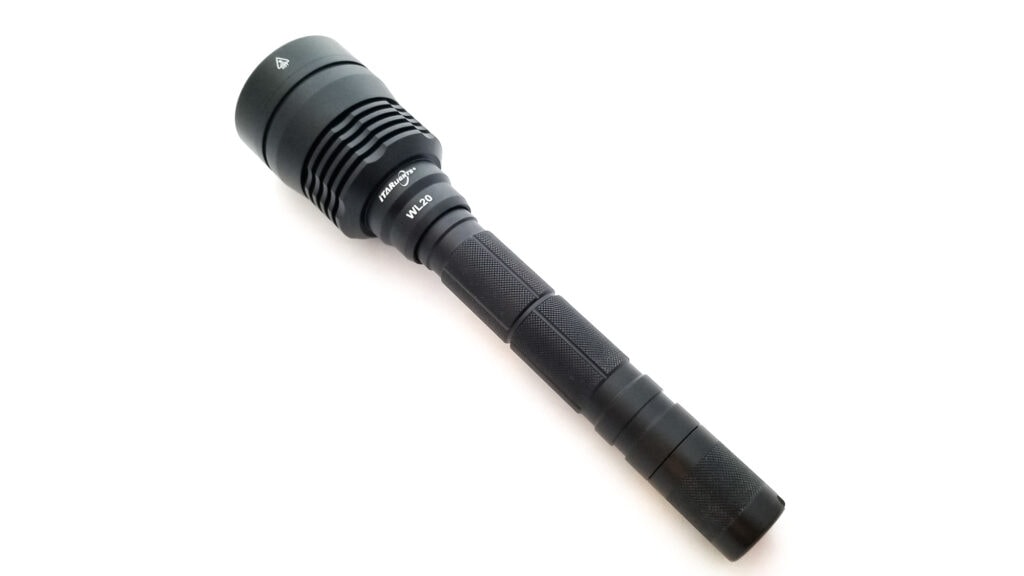
iTarlights WL20 specifications
| Brand & Model | iTarlights WL20 |
|---|---|
| Flashlight category | Long-range thrower |
| LED | Shine through LEP |
| Max. output | 580 Lumens |
| Max. beam distance | 3,000 meters |
| Max. beam intensity | > 200,000 cd |
| Battery config. | 1 or 2*21700 |
| Onboard charging | Battery has a USB-C port |
| Modes | 3 |
| Blinkies | Strobe |
| Waterproof | IP67 |
| Review publication date | October 2022 |
Introduction:
LEP technology. LEPs (laser excited phosphor) are the newest development in portable illumination, and turn a small flashlight host into a thrower capable of distances only achieved by much larger LED flashlights. If you want a long-range, no compromises thrower, LEP is the way to go. With just about every flashlight company currently making an LEP flashlight (Convoy and Sofirn…waiting on you), and some smaller companies now fielding affordable LEPs, the market has diversified quite a lot.
3 years ago, an LEP was $300, but now you can join the LEP club for about $80. A few weeks ago, I was asked to take a look at some new LEPs from a mysterious manufacturer, iTarlights. If you’ve never heard of them, that’s fine because I hadn’t either. They’re best known for making bicycle-mounted lights, sold from their merchant site www.bikeflashlights.com. Additionally, they’re an OEM and ODM manufacturer, meaning they make flashlights for other companies based on their design, or make rebranded flashlights with slight feature alterations (like Sofirn/Wurkkos, Mateminco/Astrolux). If you need a bunch of made-to-order flashlights, iTarlights has you covered.
Well, apparently iTarlights dabbles in LEPs as well, and sent two for me to check out: The dual 21700 WL20 and single 21700 WL30. The former is spec’d to offer 3,000 meters of throw, while the WL30 spec’d at 1495 meters. Not unheard of for modern, high-performance LEPs these days, but the more remarkable spec is the price. On Alibaba, the WL20 retails for under $200 US, which is pretty remarkable for a 3 km LEP. The other 3 km LEP is the Maxtoch L3K, which goes for about $350. The big question is just how much LEP can you get for under $200? Let’s find out.
Package quality.
The WL20 and WL30 came in very different packages. The WL20 came in a very nice semi-rigid zippered case filled with microcell foam with cutouts for the light and accessories with an elastic net on the opposite half for stowing the manual, etc. Everything was bagged and very nicely packaged and this is totally adequate for the price.
- iTarlights WL20
- Two 5000 mAh 21700 USB type C rechargeable batteries
- Single cell battery tube
- Dual-cell battery tube
- Manual
- Lanyard
- Two USB type C charging cables
- Split ring
The only thing missing from this is some o-rings, and I hope iTarlights is reading this and includes some since they’re wear items and will eventually wear out, especially since this light doesn’t have onboard charging and requires removing the batteries for charging. Overall, it’s still a very complete kit and everything was really nicely packaged. The two batteries were sitting at 4.12 volts as well. A bit high for storage voltage, but beneficial in that you can put the light right to work without recharging.
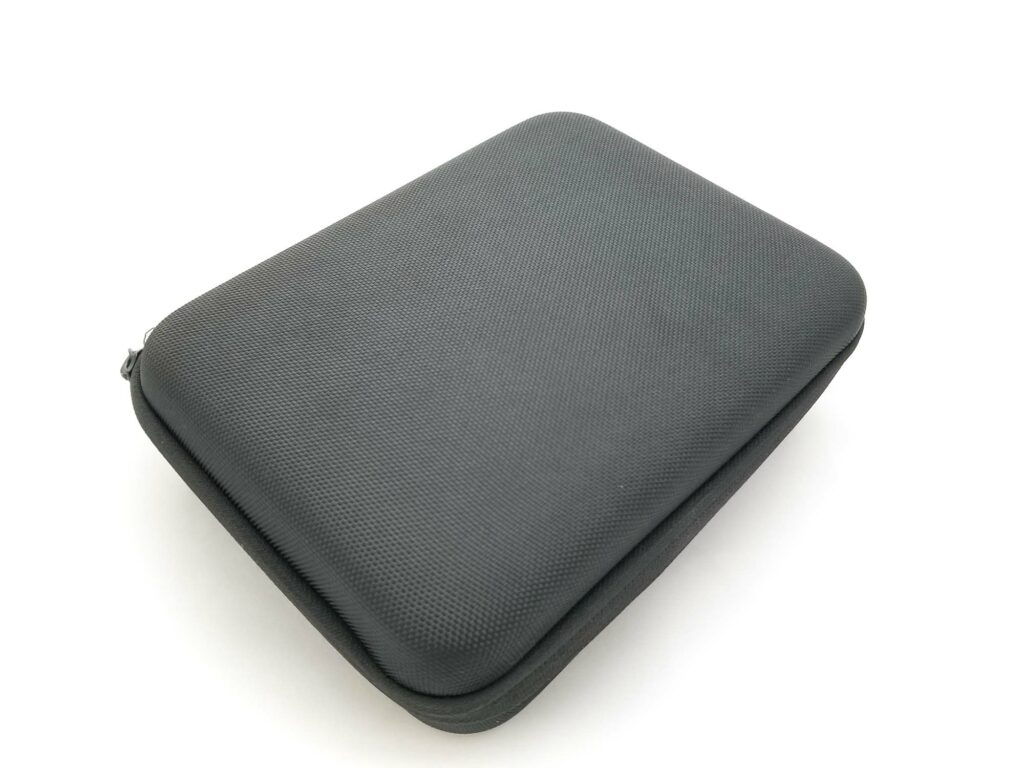
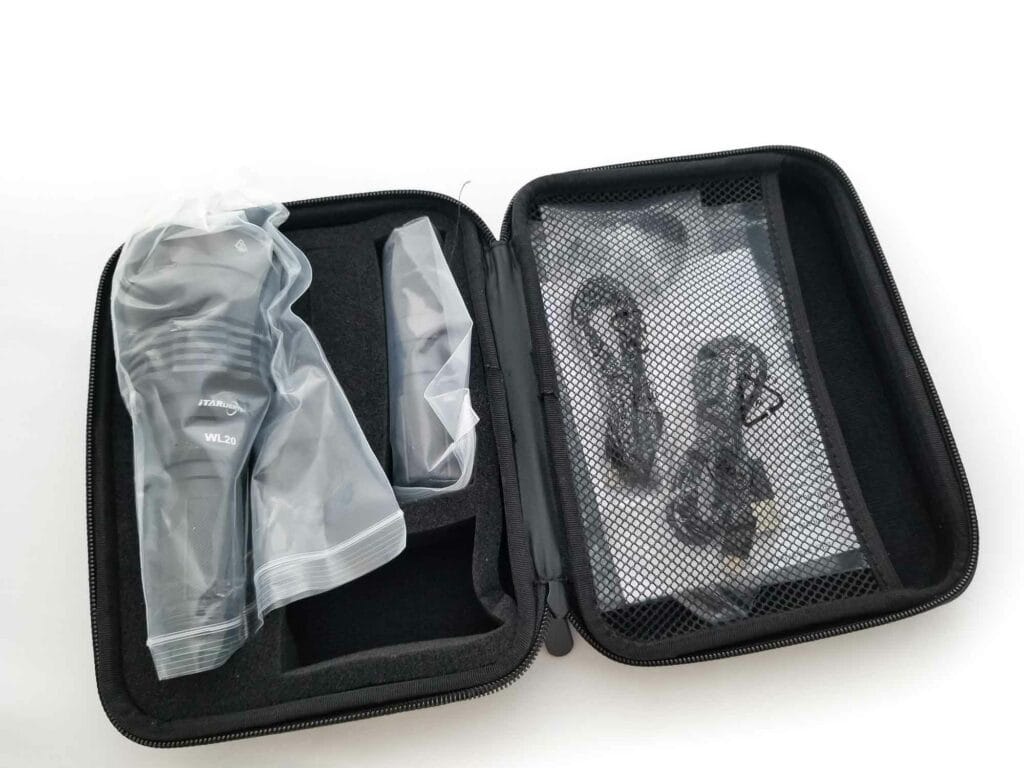
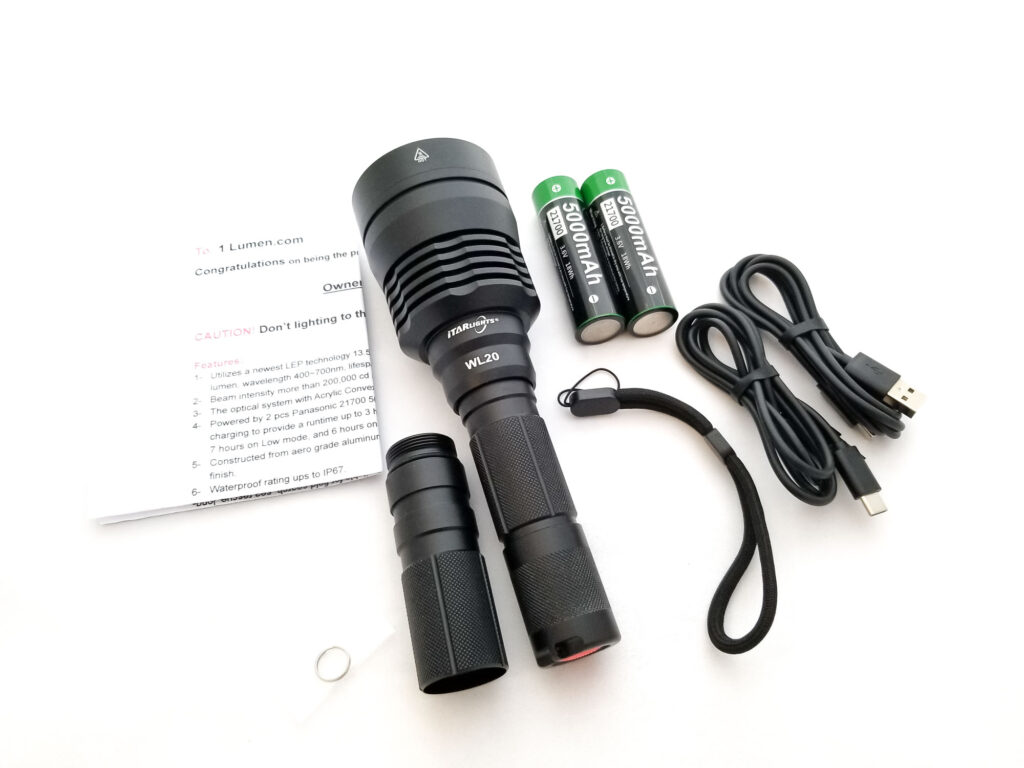
Flashlight in use
The WL20 is purpose-built for a single mission: Ultra long-range illumination. Period. It’s not really useful for anything else. If you need to light up a human-sized object at 2000 meters (provided you can see that far), this is the light for the job. The main benefit of an LEP over a comparable LED flashlight is the size. LEPs are a lot smaller for the same amount of throw.
The Amutorch DM90, for instance, managed about 2300 meters with a 125 mm head. The WL20 has a 62 mm head (and throws much farther). It’s also quite a bit lighter and less bulky. Handling-wise, the WL20 feels big. It has a lot of heat sinking and thermal mass. Since it can be used with two 21700s or a single 21700, it handles a bit like a larger, heavier Nitecore MH40S or a Convoy L21B. It’s decently balanced in the two cell configuration, and very front-heavy in single cell guise. There’s some fine knurling combined with some horizontal grooves on the battery tube for gripping, and it’s pretty effective.
The light has nice heft to it, as well. Switching is by means of a reverse clicky at the tail. No e-switch this time, so again, it’s the full Convoy L21A or L21B experience here. The switch is decently-weighted and has a nice feel with solid clicks. This light does best in the saber or icepick grip due to the length, and changing modes is a 2-handed exercise, but switching to the single cell tube really helps out the handling quite a bit since you can reach the rear switch with one hand.
There’s a lanyard mounting point on the removable tailcap for threading the included lanyard, or mounting the split ring for the lanyard. There’s nearly no anti-roll features on the light, so it will roll away on an incline. Tail standing? Do it at your own risk since it’s very unstable. iTarlights didn’t include a holster with the WL20, and I think it really needs one since belt carry is one of the only other options.
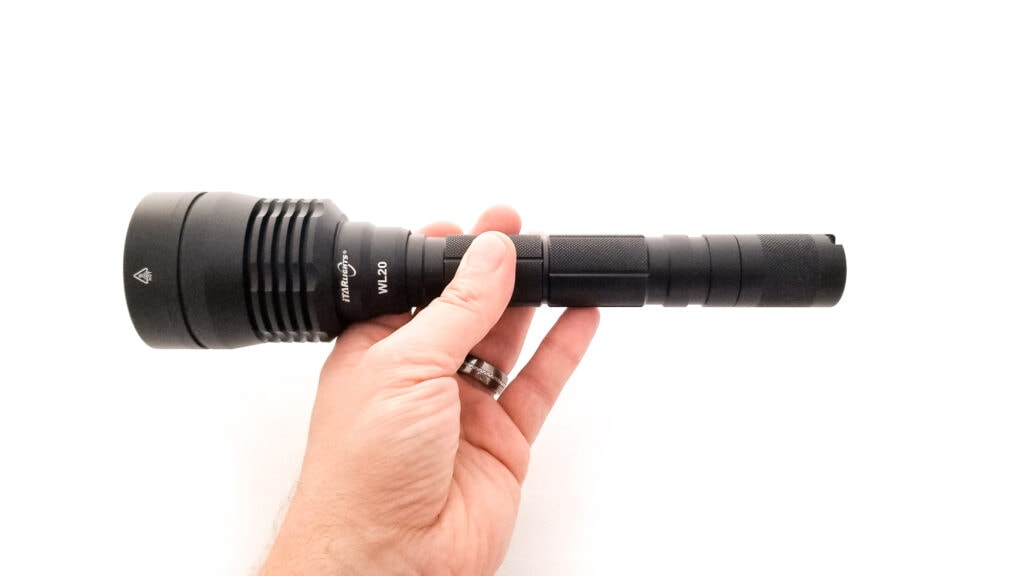
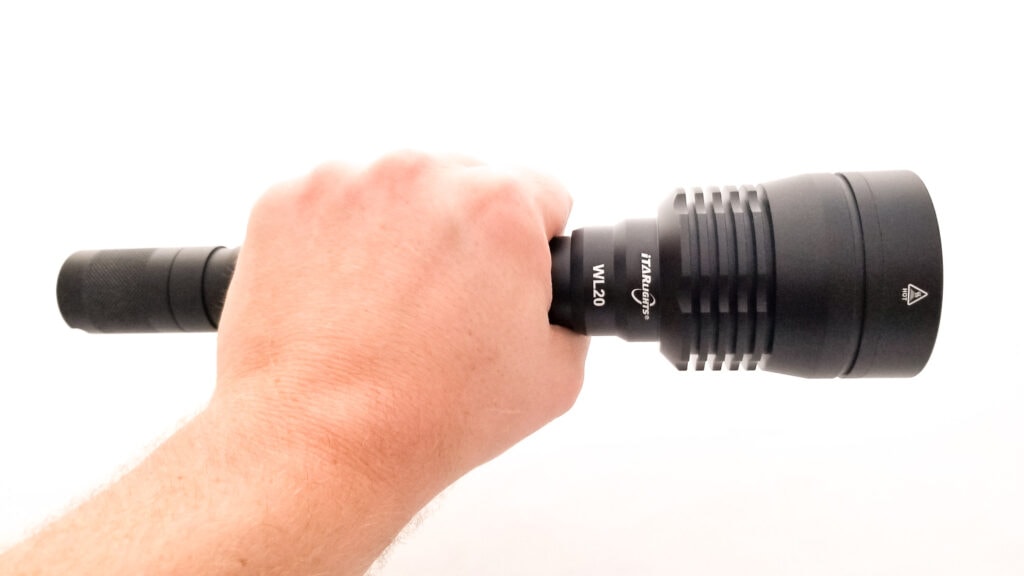
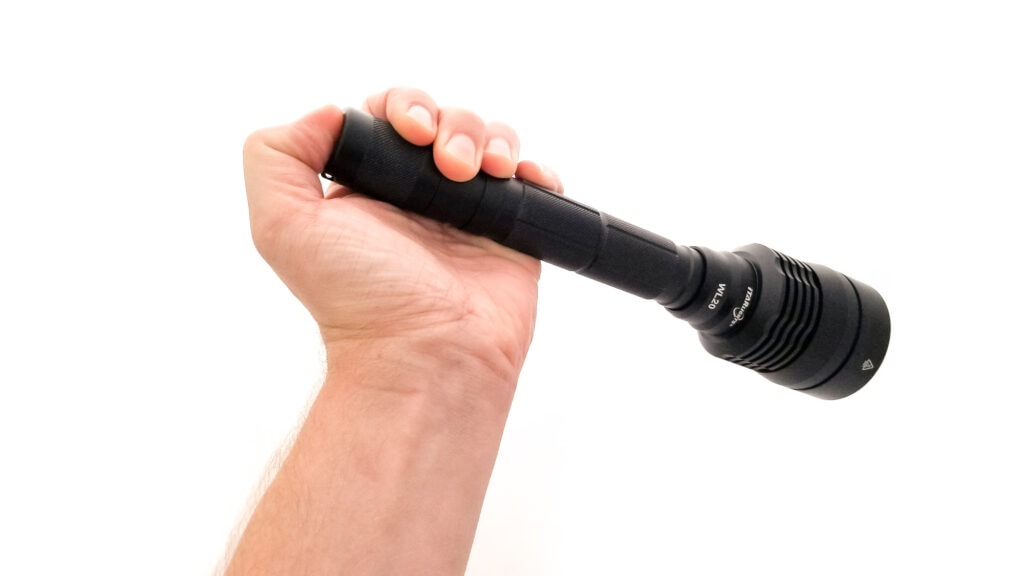
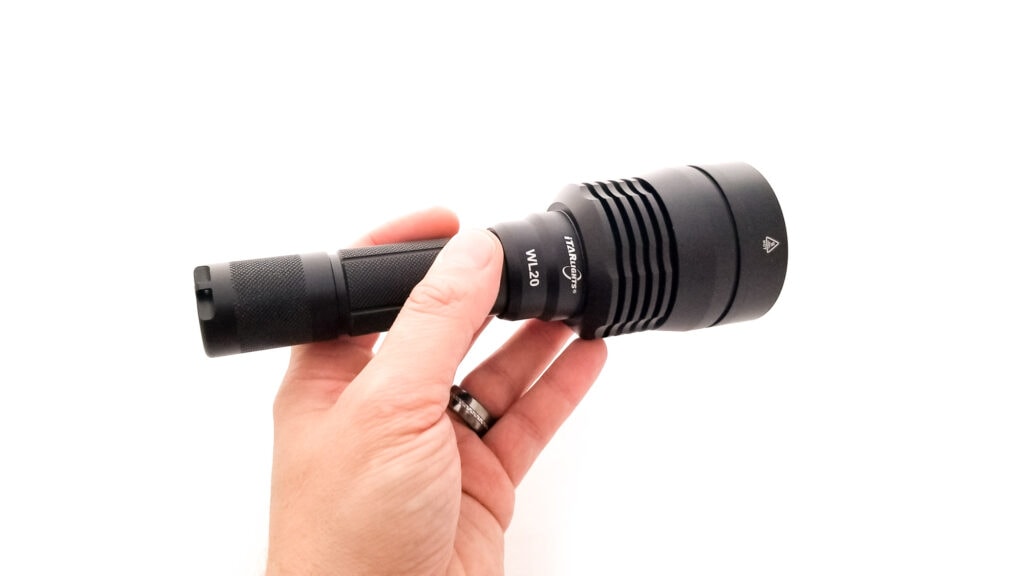
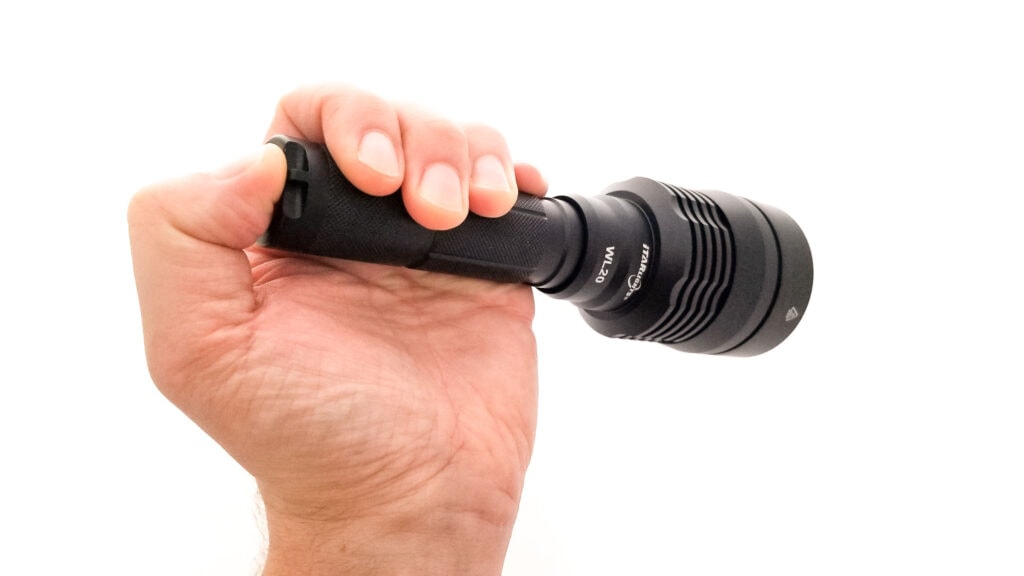
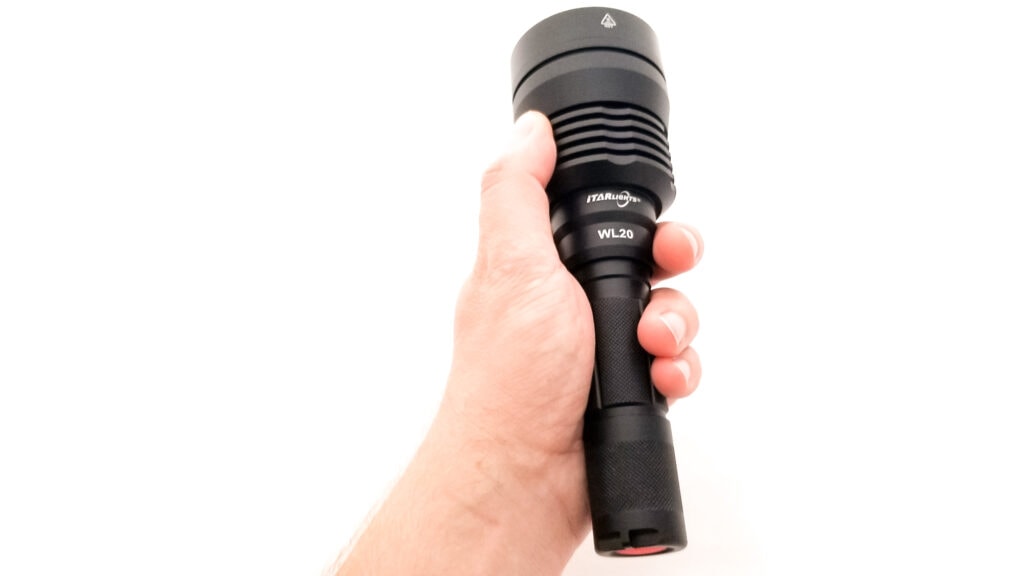
Build Quality, and Warranty
iTarlights is an unknown brand to 1Lumen, and I’ve never come across them in the wild, but after spending some time with the WL20, this seems like a solid light. It’s well-made and doesn’t seem cheap. If you’re looking for an “affordable” way to get into the 3 km flashlight club, then this is it since the WL20 retails out on Alibaba for around $170 US. That’s a fantastic deal for a 3 km-capable LEP, so has iTarlights compromised anywhere to get it under $300?
The parts fit together fine, and aside from the patterns on the two-piece battery tube not lining up, there’s no major quality concerns. However, one glaring fault was the lenses. The outer lens was pretty dirty and I was able to clean it, but the inner lens was a mess of residues and crud. I was able to unscrew the bezel and the outer lens came out, but the inner lens is held in with a retaining ring al-la a DSLR camera lens element.
I didn’t clean it because I didn’t want to damage or scratch it. The light is made from an unknown aluminum, but it’s nicely machined, with no errant tool marks or blemishes. There’s no sharp edges either since it’s been given a carry melt treatment. The only abrupt edge is the lanyard mount on the tailcap. The finish isn’t specified either, but it looks like a type III HA and it’s a matte black that’s a little shiny, but not overly so. It’s nicely done as well, with no blemishes or thin areas. The silkscreen text looks good too with nice contrast.
The threads are fully anodized triangular cut units that seem sturdy enough, but they were bone dry and made screeching noises when tightening or unscrewing the tailcap and tube segments. Lube those threads, folks!
The batteries included with the light fit very precisely in the tube, and didn’t rattle around at all. The tube segments, bezel, and tailcap are sealed with o-rings, and iTarlights gives the WL20 an IP67 rating. I believe it.
The tailcap has a captured, plunger-style brass contact, and the driver has a short steel spring for the positive contact. Not the greatest for a low-resistance current path, but this light doesn’t need one. Dual springs are superior to a solid contact/spring arrangement anyway for protecting the driver and preventing connection breaks if the light is dropped. The driver is removable after unscrewing an aluminum retaining ring, so it can be swapped if needed. No warranty information was included with the light, but over at iTarlights ecommerce site bikeflashlights.com, they mention a 2-year warranty. I presume it covers the usual pleasantries, DOA, workmanship issues,etc.
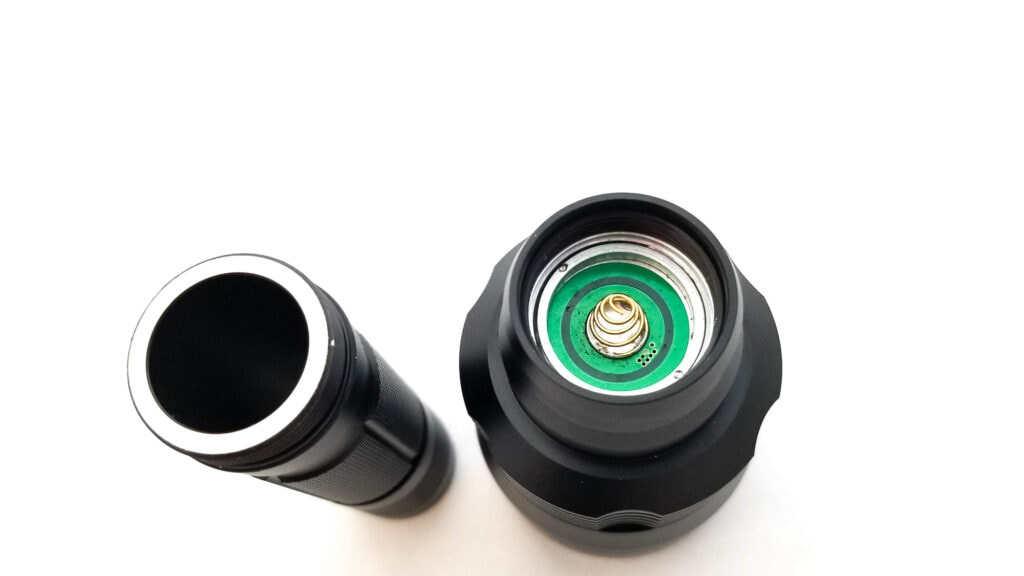
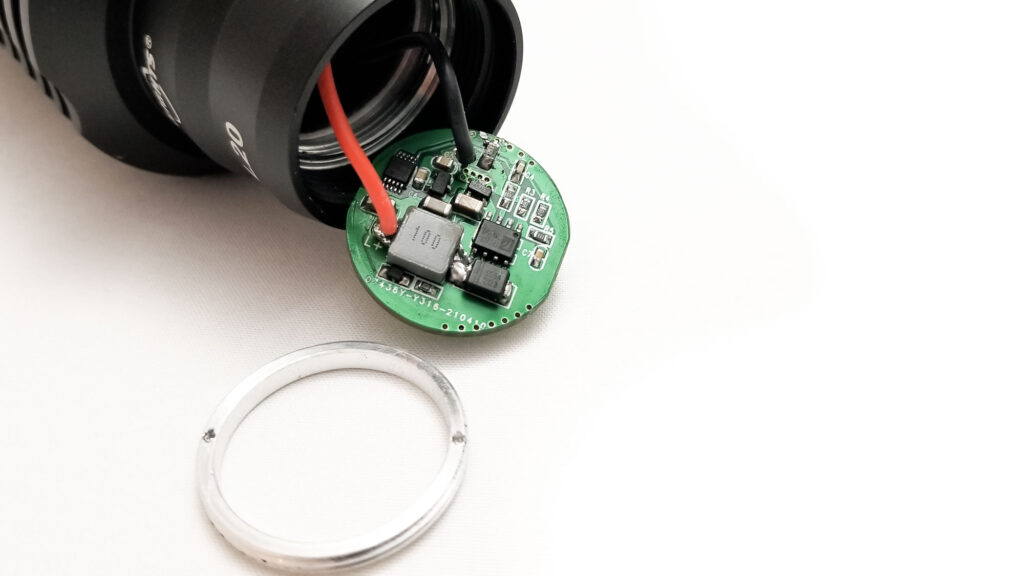
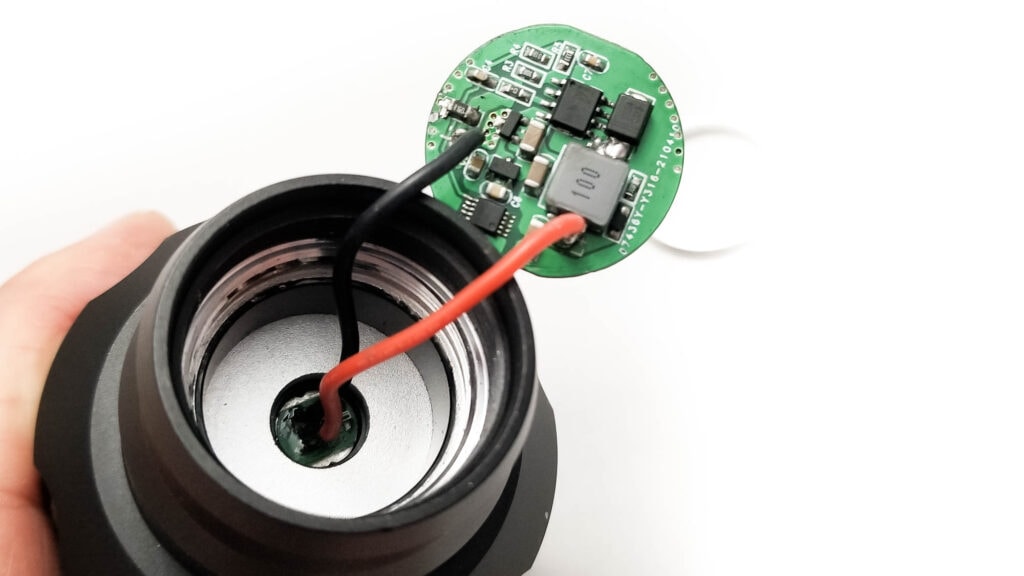
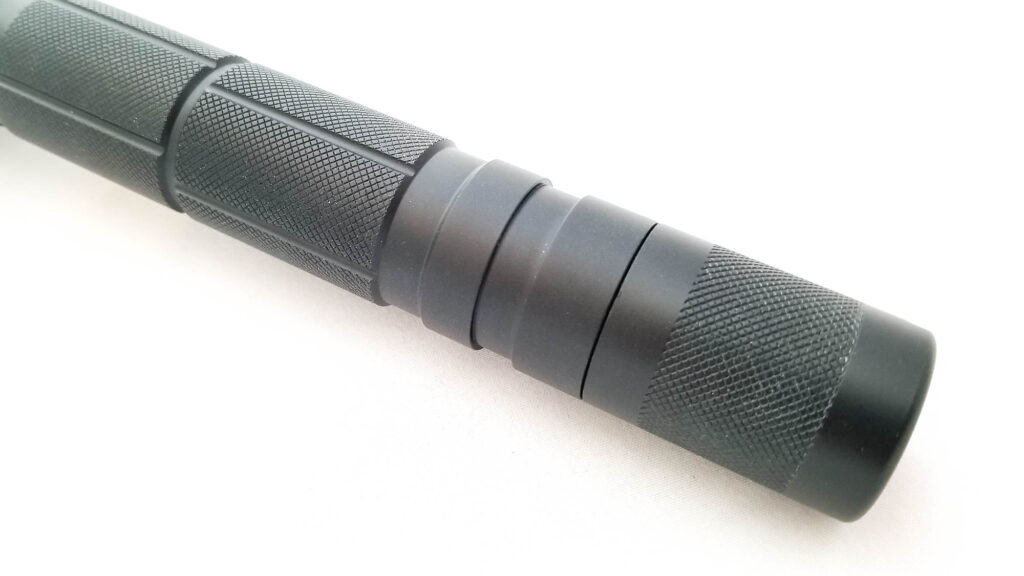
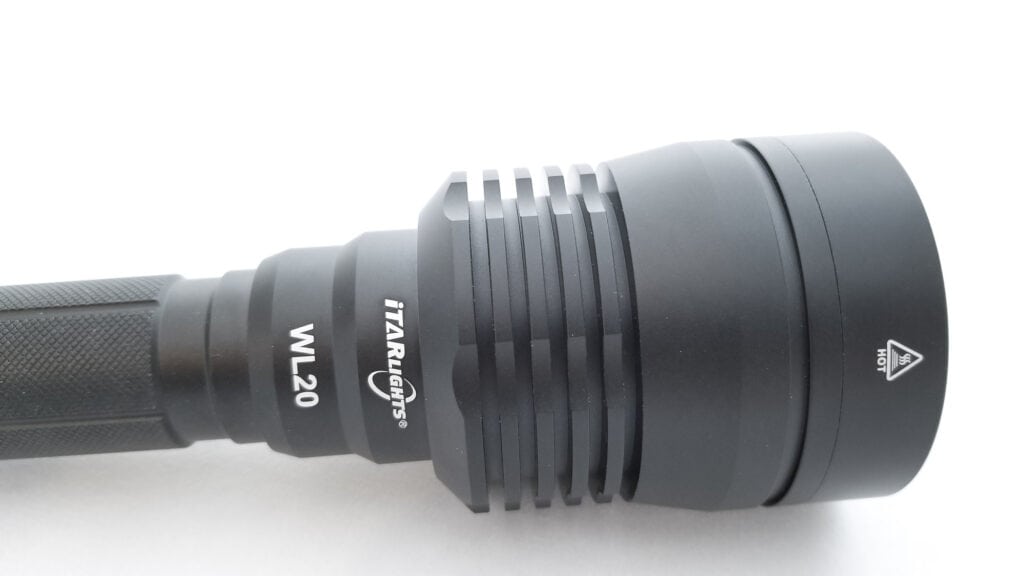
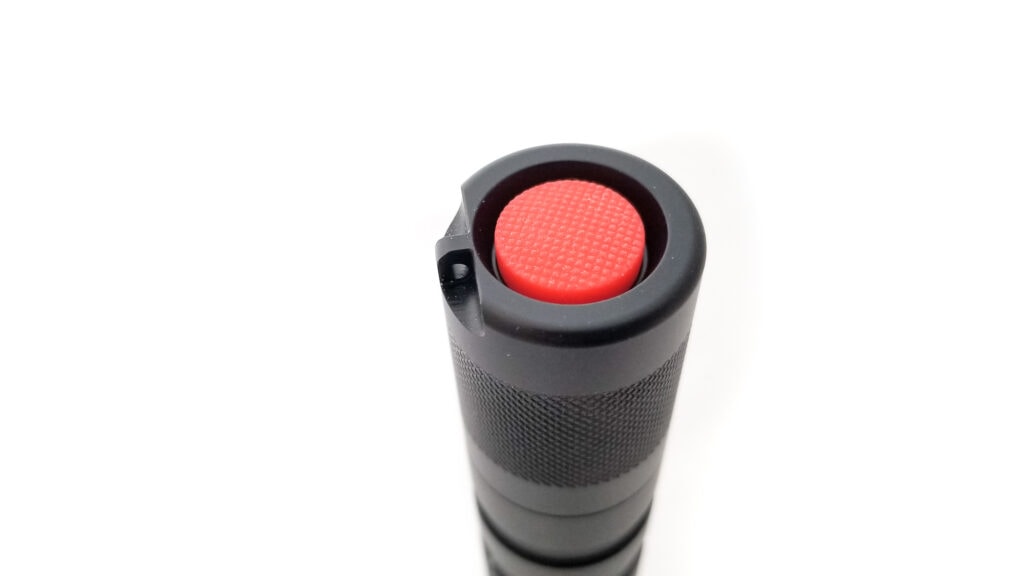
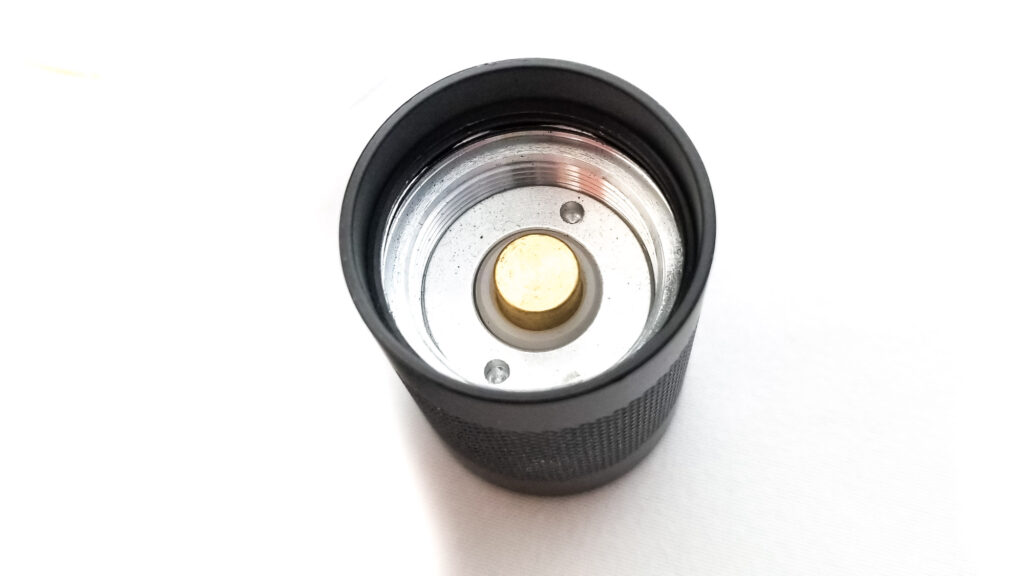
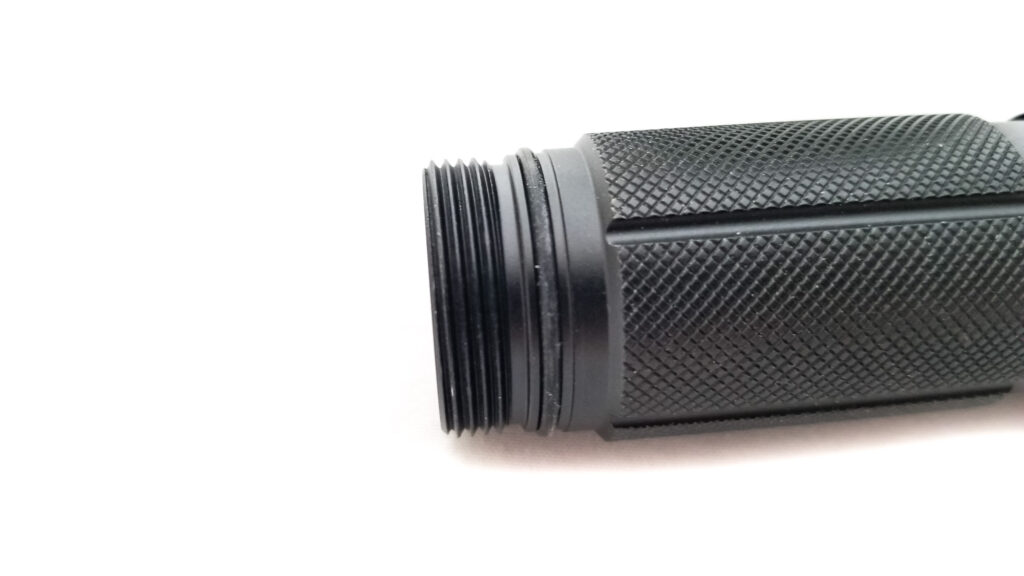
LEP, Lens, Bezel, Beam, and Reflector
The WL20 is an LEP thrower. LEPs, also known as white laser flashlights, shine a pumped blue laser beam through (or off) some phosphor to change the laser beam to a white-ish color. It then directs the beam through aspheric lenses to focus it into a flashlight-like appearance and increase the throw.
There are two types of LEP modules: the shine-through and mirror-type.
Shine through LEP modules (like the one on the Natfire SF2) are the newer technology and are cheaper to produce, but don’t typically have the same performance as the mirror type modules. On the other hand, they’re more consistent in color and more closely mimic an LED flashlight.
Mirror type modules are higher performance and are featured in the longest-throwing LEPs on the market (the Maxtoch L2K and L2Kd), but their beams are more on the yellow side and typically pretty ugly. With the bezel off, peaking through the lens it appears the WL20 is sporting a shine through module.
One area costs are usually cut on LEPs is the optics, specifically plastic optics not protected by a lens, so I was glad to see the WL20 features a plastic (maybe polycarbonate) lens protecting the aspheric lens. This is important since the aspheric lenses on LEPs are pretty specific and generally aren’t off-shelf parts if they break or get damaged. The aspheric lens also seems to be AR-coated. The beam is typical LEP with no spill and all hotspot. There’s a donut hole in this one out to about 1 meter, but beyond that, it’s very intense and focused. There’s a bit of corona around the hotspot, and the overall tint is cool white.
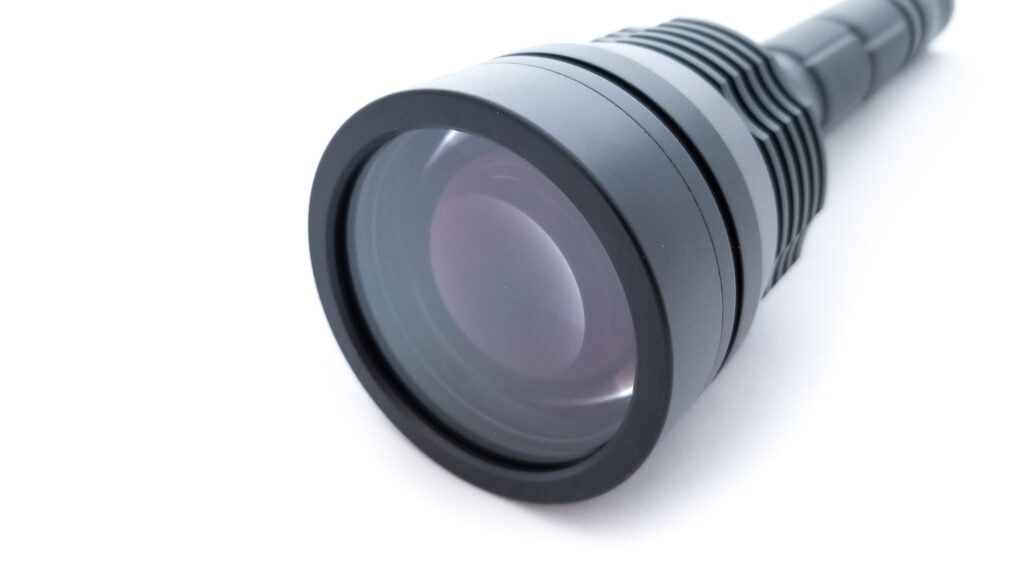
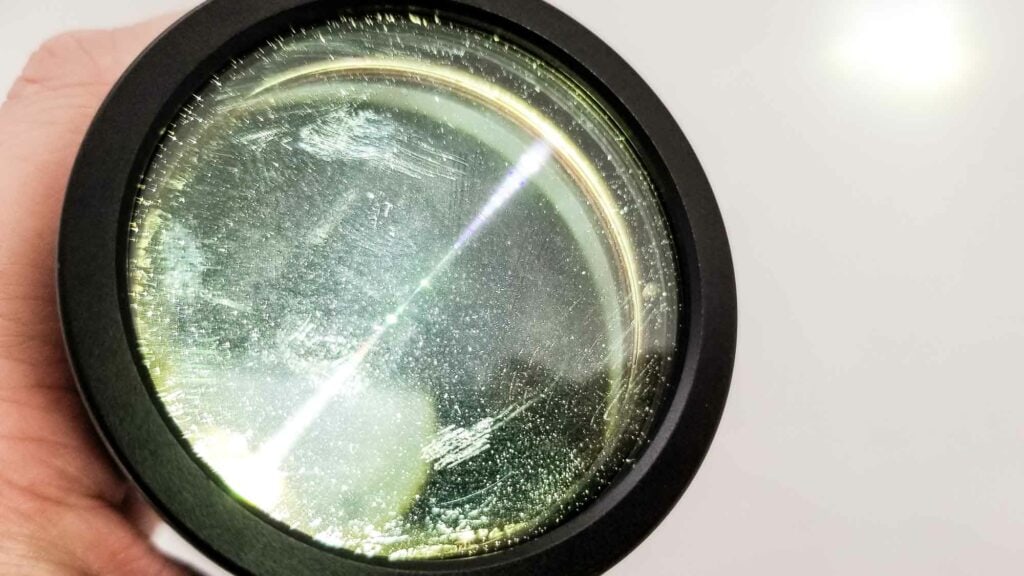

Dimensions and size comparison
Dimensions:
| Dimension | Millimeters | Inches |
|---|---|---|
| Length (1×21700) | 195 mm | 7.6 |
| Length (2×21700) | 266 mm | 10.4 |
| Head diameter | 62 | 2.4 |
| Body diameter | 29 | 1.4 |
Weight:
| Weight | Grams | Oz. |
|---|---|---|
| Without battery (dual tube) | 391 | 14 |
| Without battery (single tube) | 348 | 12.2 |
| With two 21700 | 558 | 19.6 |
| With single 21700 | 429 | 15.1 |
Flashlight size comparison with its competition
I compared the WL20 to some other long-range LED and one LEP flashlight.
Group 1 left to right: Acebeam L19 V1, iTarlights WL20 (short tube), Speras T3R, Convoy L21B
Group 2 left to right: iTarlights WL20 (short tube), iTarlights WL30, Natfire SF2
Group 3 top to bottom: Lumintop PK21, iTarlights WL20 (long tube), Nitecore MH40S, Nightwatch NS59v1
Group 4 left to right: iTarlights WL20, Amutorch DM90, Wildtrail WT90

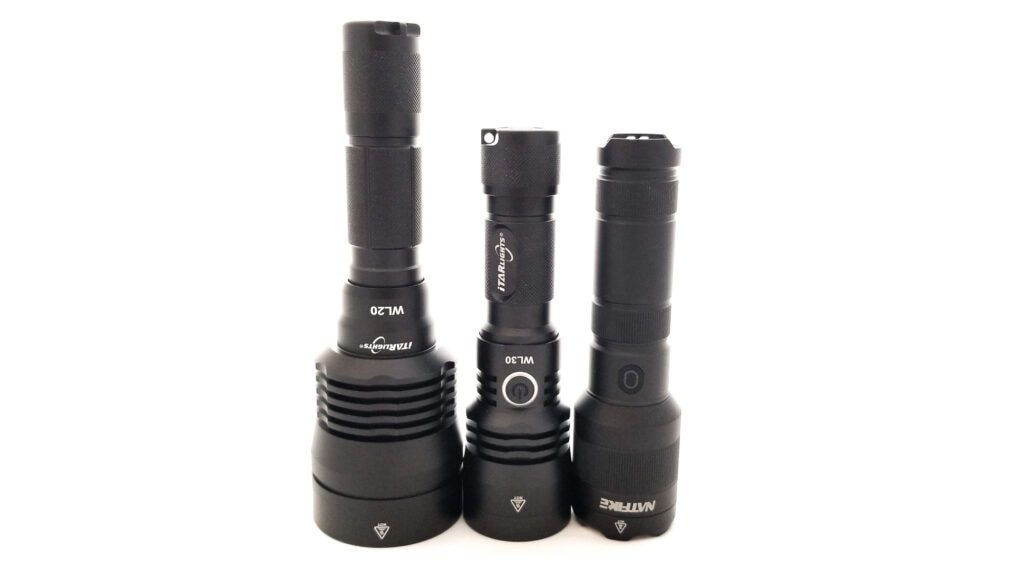
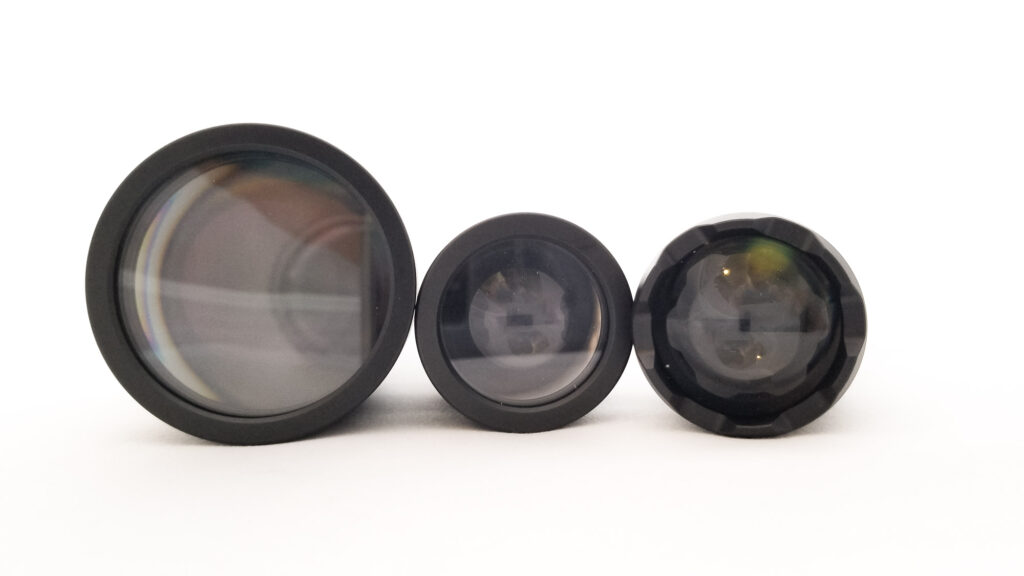
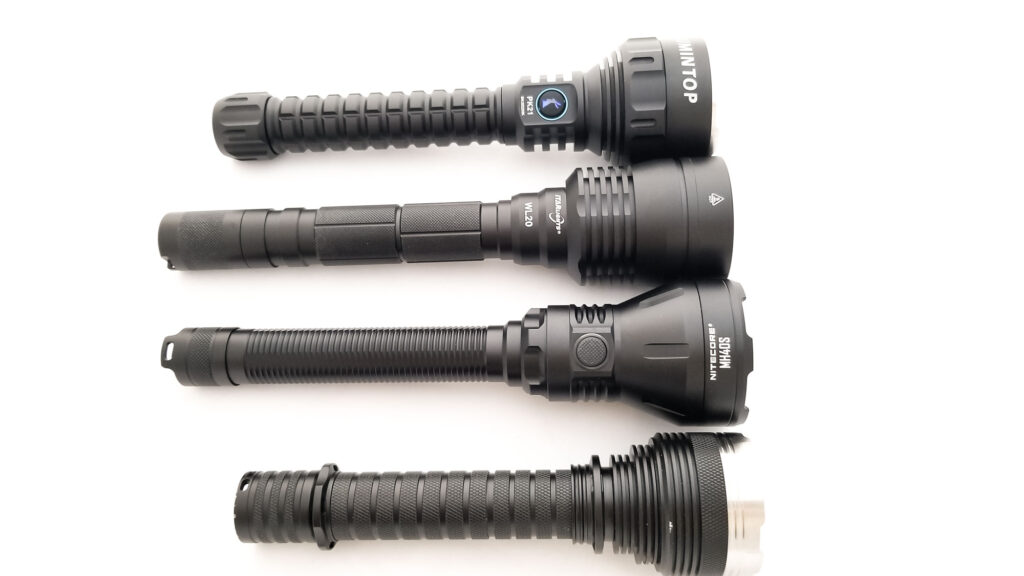
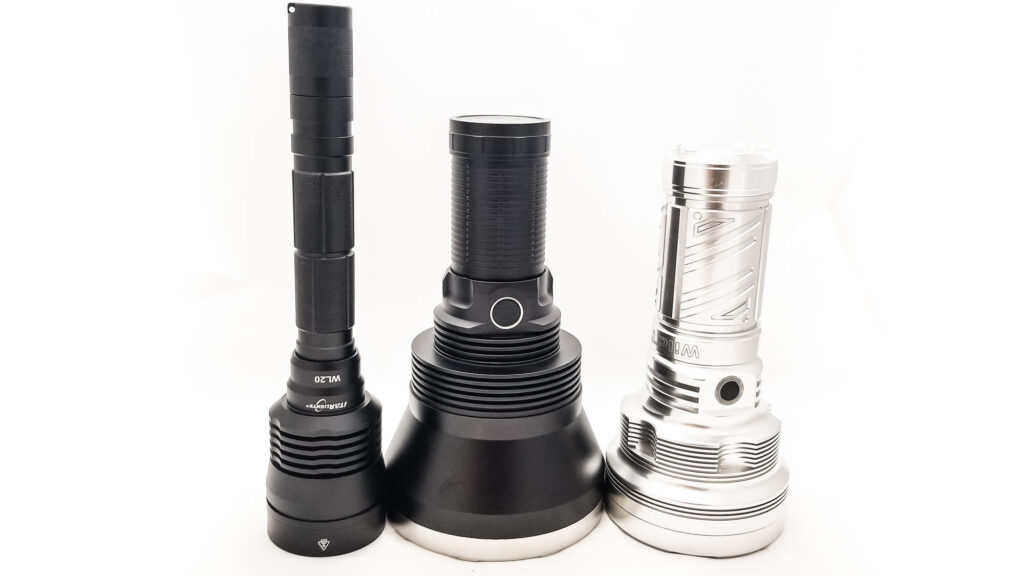
Driver & User Interface:
No driver is specified in the literature, but I removed the driver retaining ring to reveal a buck driver. This makes sense because the LEP module doesn’t particularly like 8.4 volts, so it has to be stepped down. Buck drivers are great for linear output since they don’t drop output as the batteries drain like an FET driver does.
The UI is delightfully simple, and that’s a great thing since LEPs don’t need complicated UIs. Folks, Anduril is for EDC lights, not LEPs.
Available modes: High, Medium, Low
Available blinky modes: Strobe
User interface:
From OFF:
- Single click: Turns on in the next mode.
From ON:
- Single click: Turns off
- Half-press: Switches modes H-M-L-Strobe
Mode memory:
- Next mode memory
Shortcuts:
- None
Low voltage warning:
- N/A
Strobe/blinkies
- SOS. It is part of the mode set.
Lock-out mode:
- None, but it can be manually locked out by unscrewing the tailcap ⅛ turn
PWM
- None
Additional info on the UI:
- The UI is again, very simple, and that’s just fine for an LEP with a special use-case. It’s a great clicky UI as well, and is easy to navigate. The mode spacing is nice, and there’s no PWM. No mention is made of thermal regulation, but we will see if it’s present on the runtimes. I suspect not, since the light has a lot of heat sinking and is only being driven to about 13 watts. However, I do not like that the SOS mode is part of the mode rotation and is not hidden in any way shape or form. There’s next mode memory as well, which is never welcome in a UI (even for an LEP). Turning the light off and back on again will advance to the next mode, so if in Low mode, turning the light off and on will (annoyingly) advance to Strobe.
Batteries & Charging
The WL20 runs on 21700 batteries, and my kit came with a single 21700 and a dual 21700 tube. The light came with two button top unbranded 5000 mAh 21700s with USB type C charging. These look similar to other integrated charging 21700s on the market, so chances are these are just rewrapped batteries. iTarlights claims these are Panasonic cells, but without getting them buck naked, I can’t confirm that. I can confirm that they’re very long and barely fit in my VapCell S4+ charger.
The good news is they aren’t proprietary, so you can swap in any 21700 so long as they fit. I tried some Samsung 50G button tops and they fit fine. The package included 2 USB cables and that’s really nice since you’ll need them if you don’t have a charger for them (you need one that will accept 77 mm long 21700s). They fit in my VapCell S4+, but I had to shoehorn them in there.
The USB type C charging works fine, and it’s rated for 5V 1A. Charging is indicated by means of an opaque ring around the positive contact that turns red for charging, and blue for fully charged. These also have bidirectional charging (powerbank) capability like Acebeam’s 5000 mAh 21700s. It’s rated for the same 5V 1A. I hooked up a fully charged battery to charge a power bank, and it charged it at 4.8V and 1.33A. Although the light works with a single 21700, only a single mode and Strobe are available, probably because the buck driver limits output since it wants to see 8.4 volts input not 4.2.
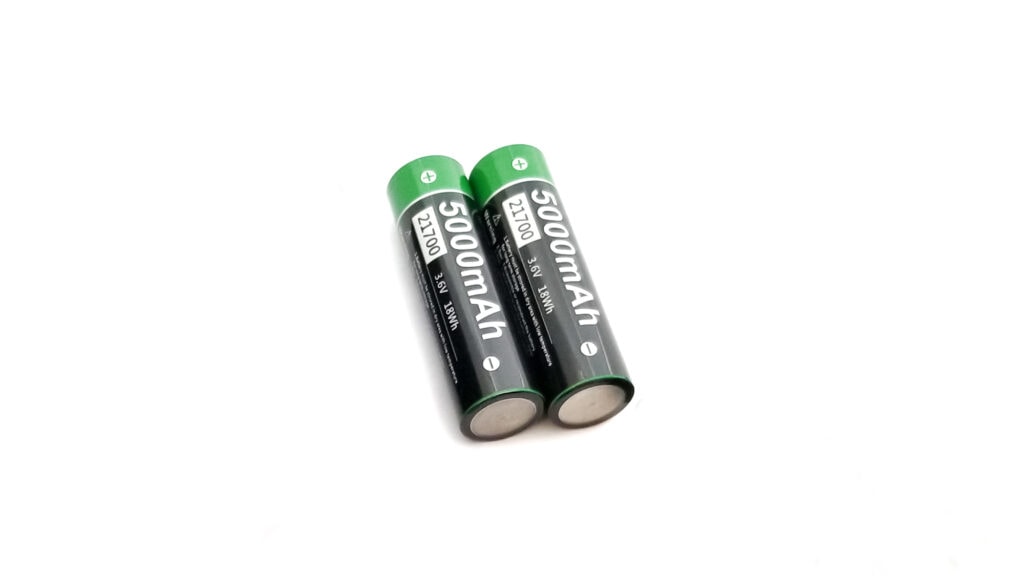
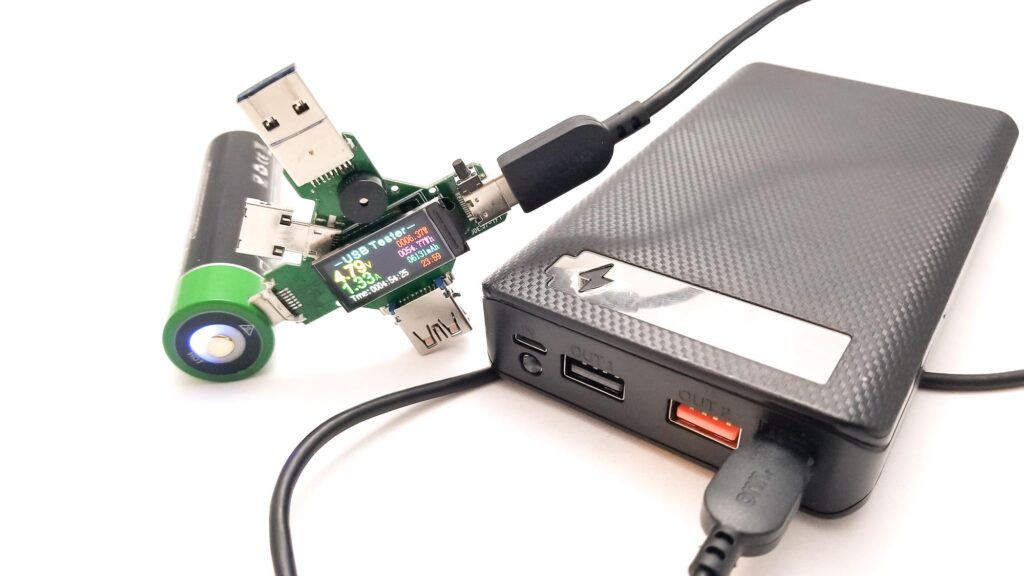
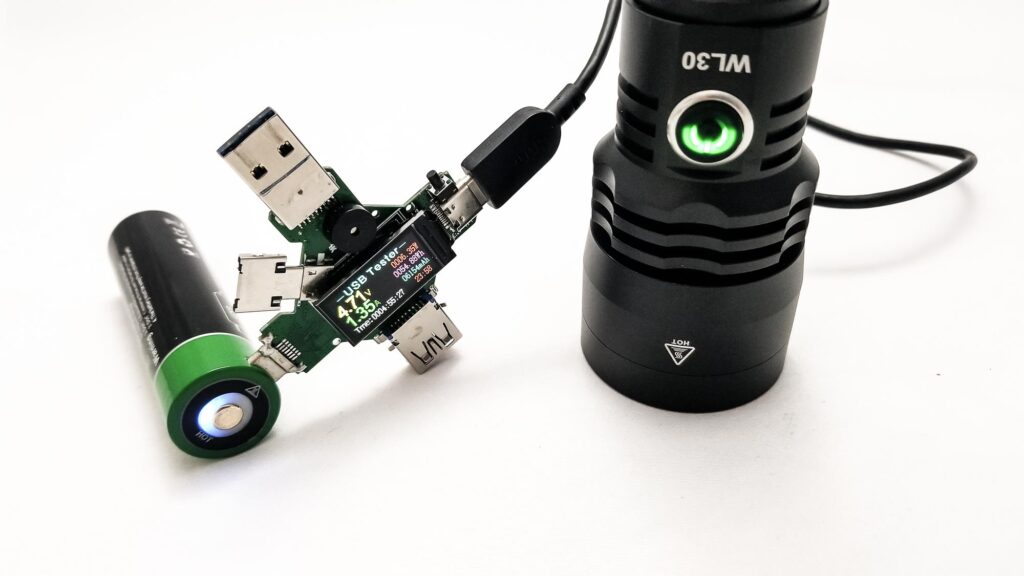
Performance test
Lumen measurements
Lumens are measured using my home made 50 cm integrating sphere, and I use a Digi-Sense 20250-00 datalogging luxmeter. The sphere has been calibrated using a Convoy S2+ calibrated to 260 Lumens and is accurate within 10% of actual output. All measurements taken at 30 seconds. Amps were measured using the two 5000 mAh batteries charged to 4.19 volts. Current measurements taken with my Thsinde 18B+ multimeter with 14 gauge wires in the meter and higher currents with my FY219 clamp meter and a loop of 12 gauge wire.
| Mode | Amps at start | Specified | turn on | 30 sec | 10 minutes |
|---|---|---|---|---|---|
| Low | 320 mA | 100 | 102 lm | 101 lm | 96 lm |
| Medium | 790 mA | 280 | 285 lm | 299 lm | 286 lm |
| High | 1.88 A | 580 | 5299 lm | 504 lm | 394 lm |
Parasitic drain:
- 0.30 mA
This is a buck driver with series cells, so the figure shown here is the input current to the battery, not the actual current to the LED, which may be higher. Oddly, Medium mode output increases after 30 seconds, and hits 300 Lumens by 45 seconds, but otherwise no drama. The buck driver provides flat output until LVP pulls the plug, and quite abruptly. Temperatures are held in check, coming in under 60 C max, meaning the light was hand holdable the entire runtimes.
Battery Life: Runtime graphs
Runtimes are measured using my home made 50 cm integrating sphere, and I use a Digi-Sense 20250-00 datalogging luxmeter. I used the two included fully charged 5000 mAh 21700s for each test. I tested Low, Medium and High modes.

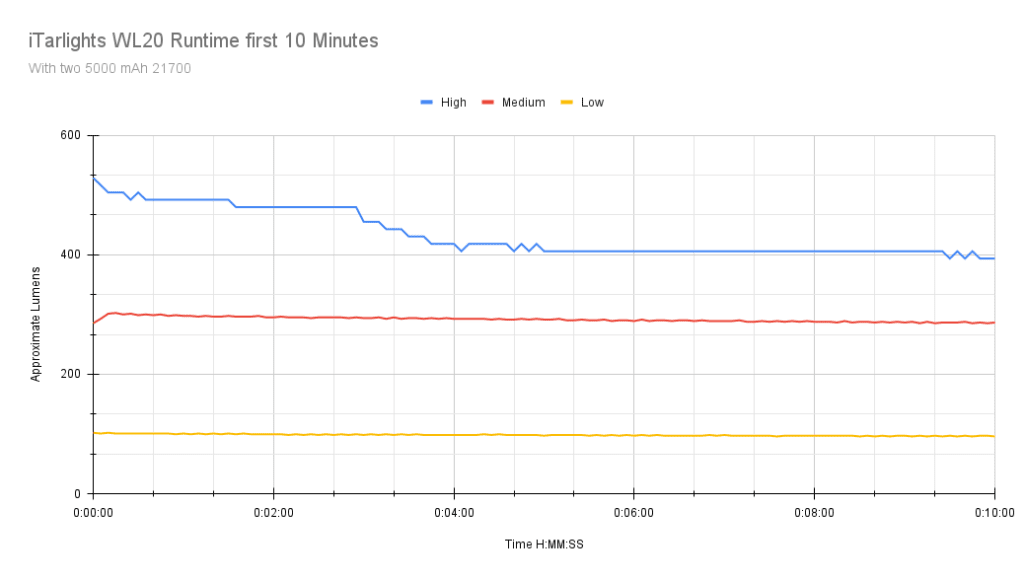
| Mode | Specified | Measured runtime (ANSI) | Time till shut off |
|---|---|---|---|
| Low | 16h | 12h 09min | 12h 09m |
| Medium | 6h | 4h 55m | 4h 55m |
| High | 3h | 2h 39m | 2h 39m |
I was expecting a longer runtime for Low mode, but still, pretty good runtimes with nice, flat output thanks to the buck driver. Again, like with the WL30, the output seems noisy.
ANSI FL1 standards: The runtime is measured until the light drops to 10% of its initial output (30 seconds after turning on). This does not mean that the flashlight is not usable anymore. The last column shows how long the light actually works till it shuts off. If there is a + symbol, it means that the test was stopped at that particular point, but the light was actually still running. This happens on certain occasions, with certain drivers, firmware, or batteries.
Peak beam intensity and beam distance measurements
Beam intensity and throw was measured outdoors at 20 meters using a Uni-T UT383S luxmeter. I used the two included 5000 mAh 21700s, with each fully charged for the test. Readings taken at 30 seconds.
| Mode | Specified | Candela measured | Meters | Yards |
|---|---|---|---|---|
| Low | >40,000 cd | 412,200 cd | 1,284 | 1,405 |
| Medium | >100,000 cd | 1,276,400 cd | 2,260 | 2,471 |
| High | >200,000 cd | 2,010,000 cd | 2,835 meters | 3,101 |
2 Mcd and 2.8 km of throw are big league figures, and almost meets the 3 km spec. On High, the figure is 1.76 miles. Not too shabby. The Astrolux WP3 Marco tested beats it, but not by much. Remember, this is a sub-$200 LEP with a decent driver.
Extra info: Peak beam distance according to ANSI FL1 standards: The calculated value of distance in meters at which the flashlight produces a light intensity of 0.25 lux. (0.25 lux is about the brightness of a full moon shining on an object).
Beamshots
I compared the iTarlights WL20 to some other long range LED flashlights and two LEPs. Photos taken with my Samsung Note 8 set to 0.5s ISO 400 and 5000K WB. The tower is 950 meters away.
Beamshots of the following flashlights compared:
- iTarlights WL20 LEP
- iTarlights WL30 LEP
- Natfire SF2 LEP
- Nitecore MH40S
- Convoy L21B
- Acebeam L19 v1
- Amutorch DM90
- Speras T3R
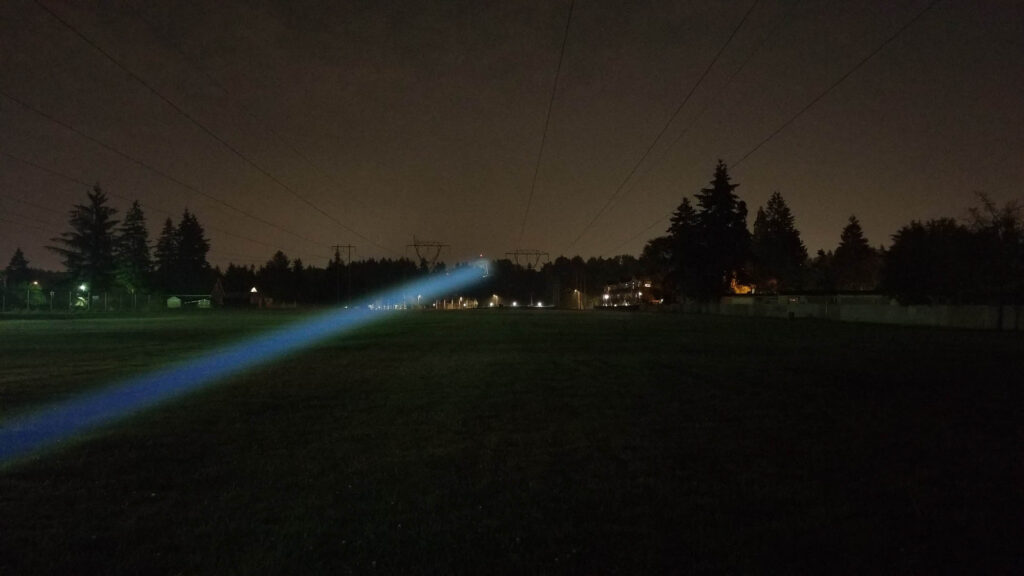
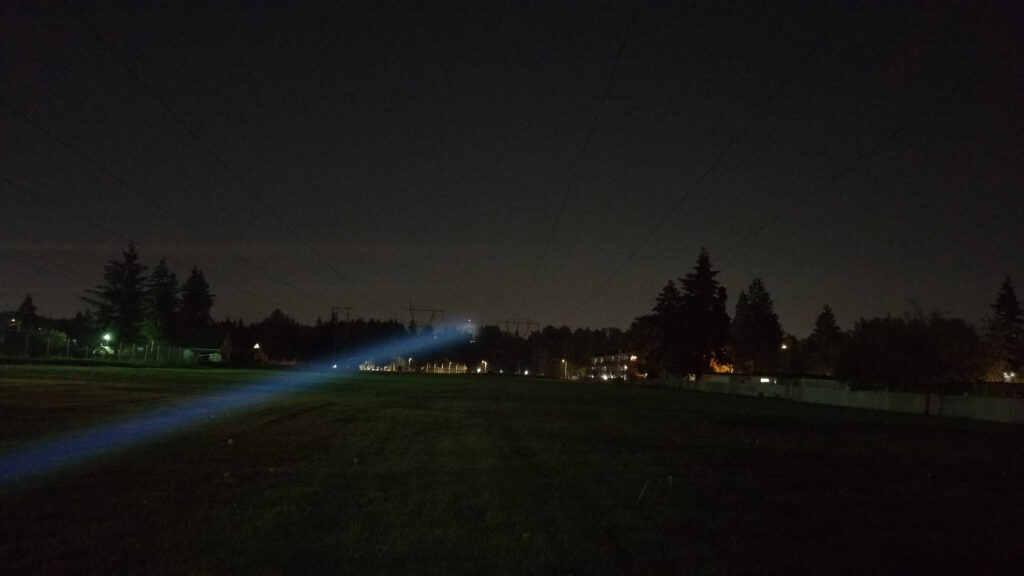
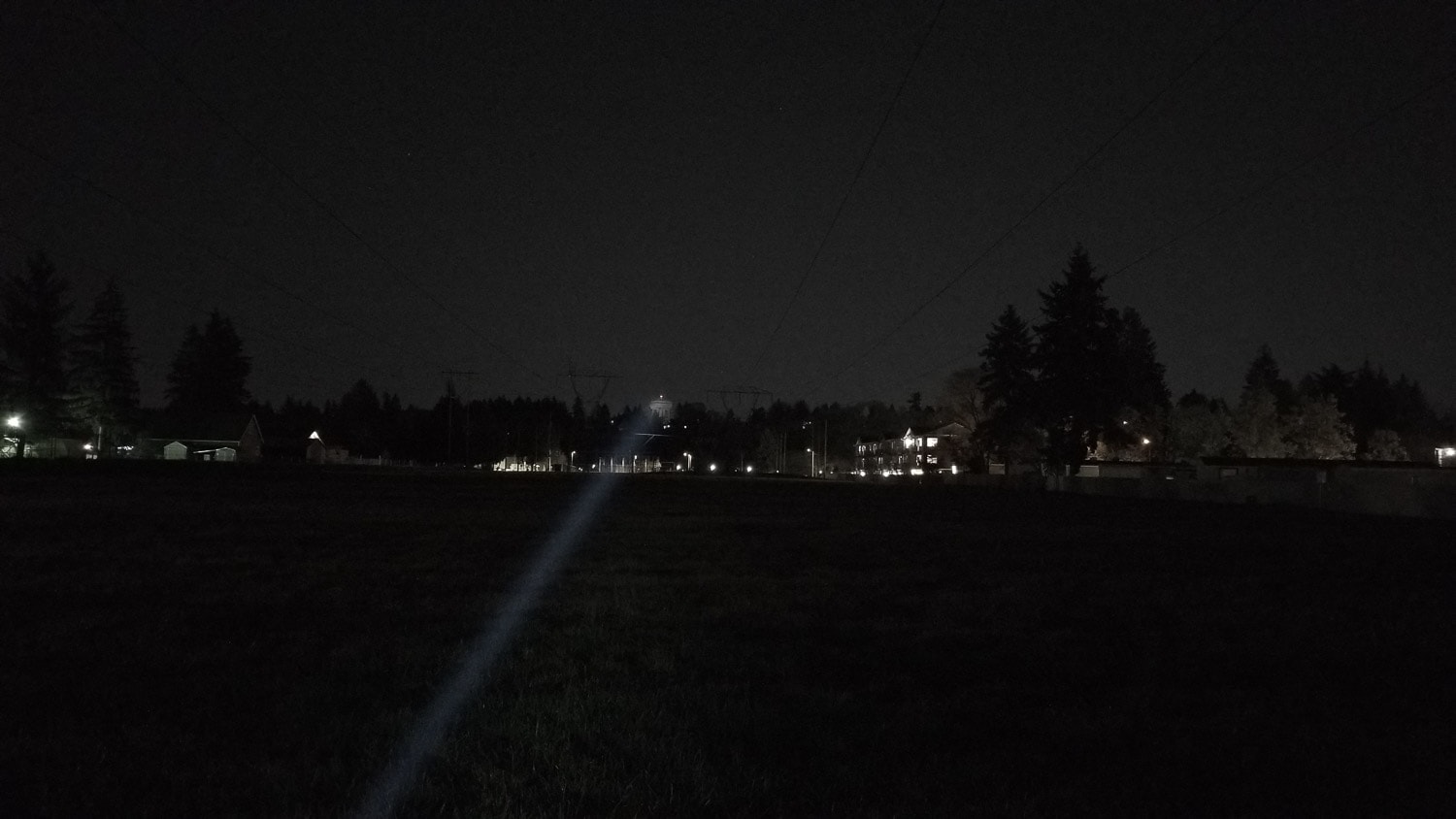
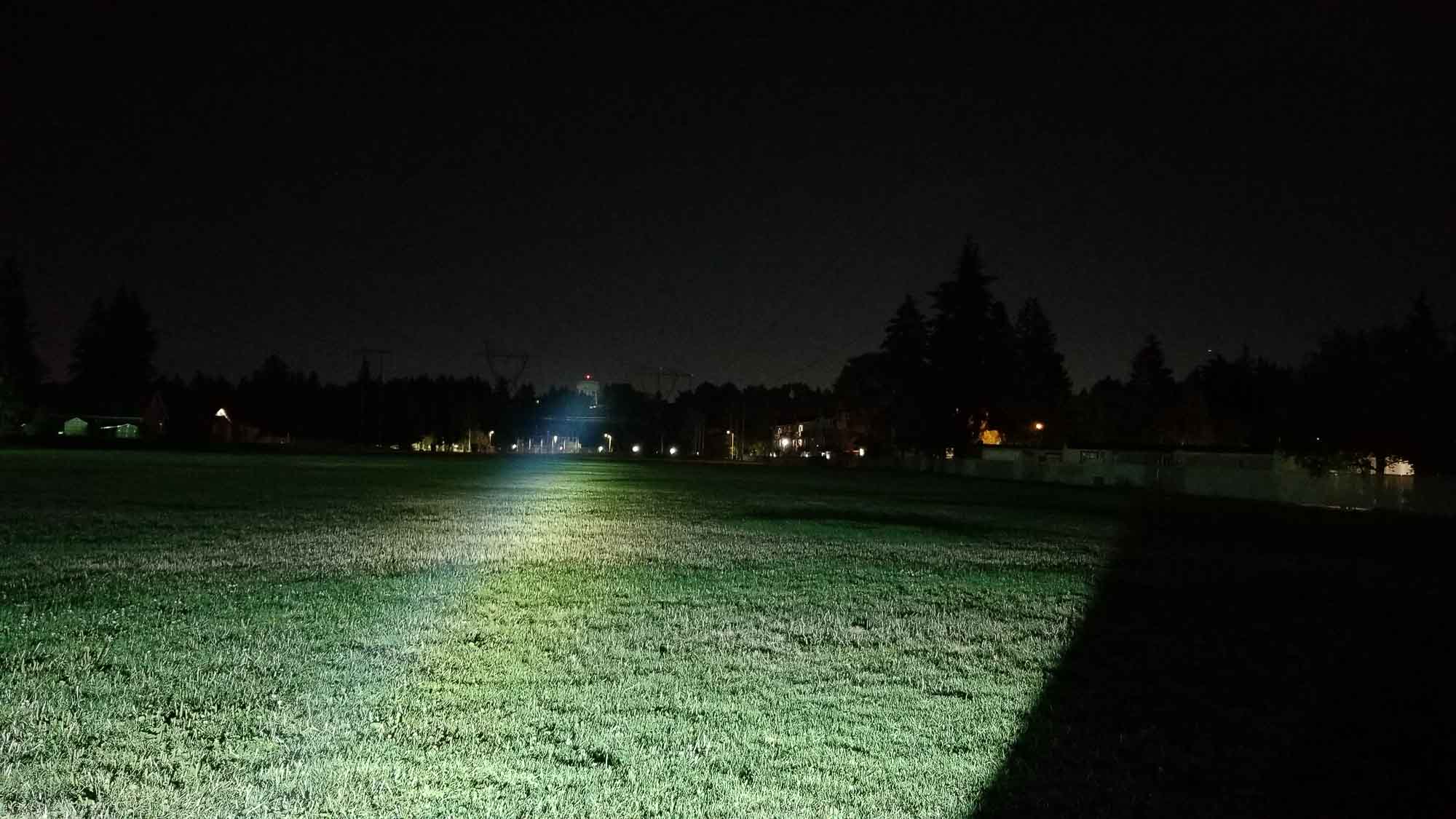
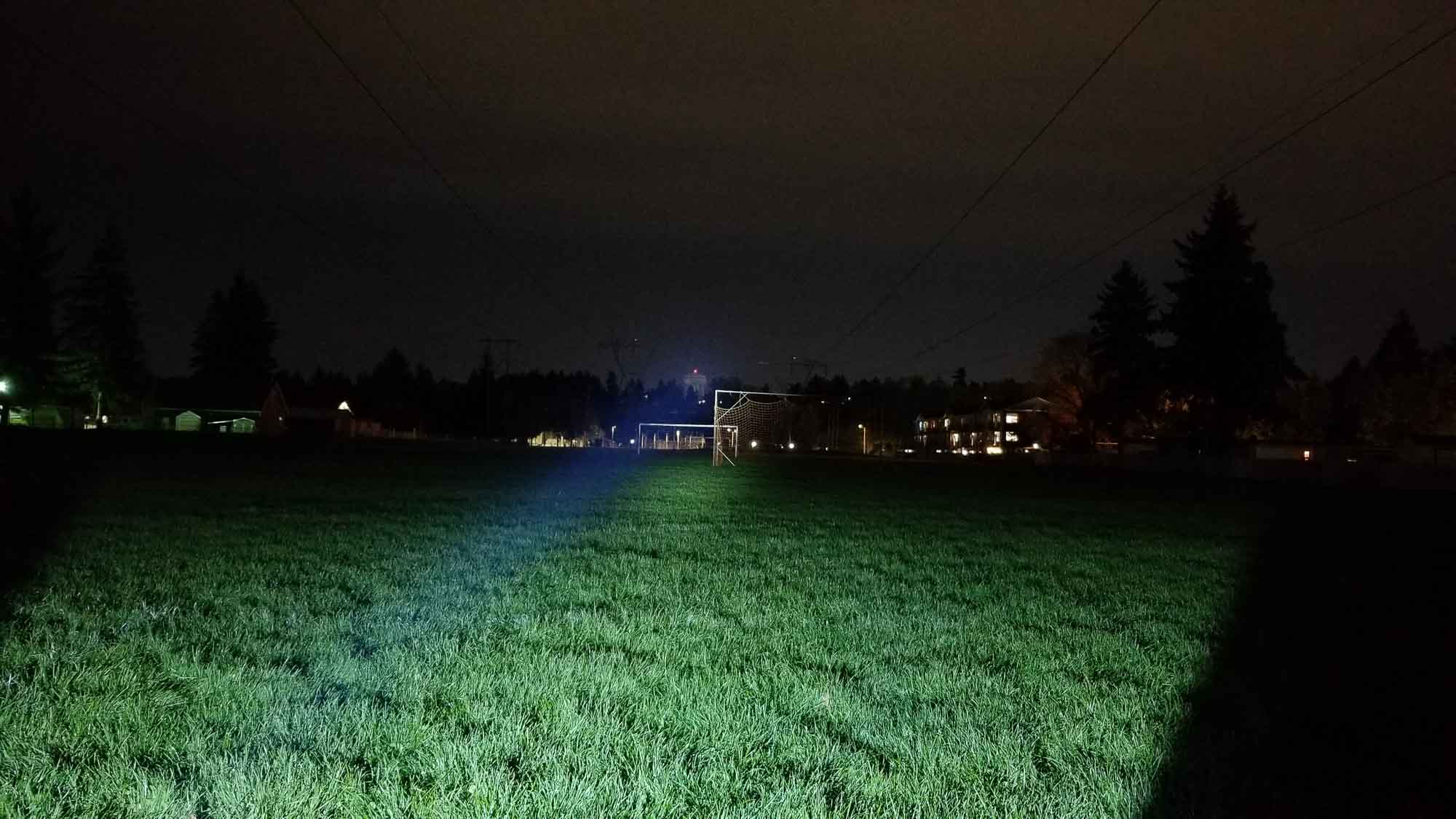
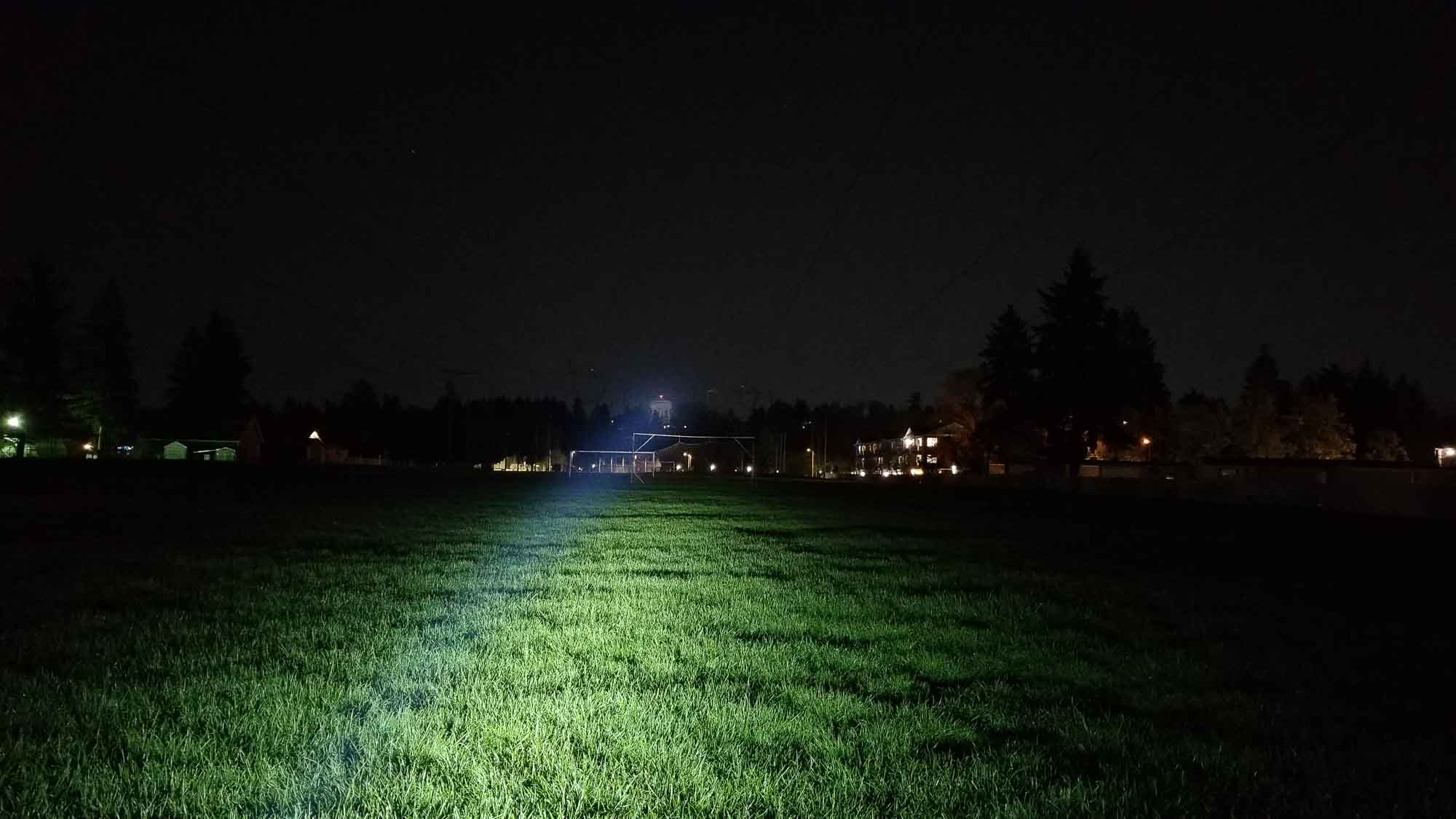
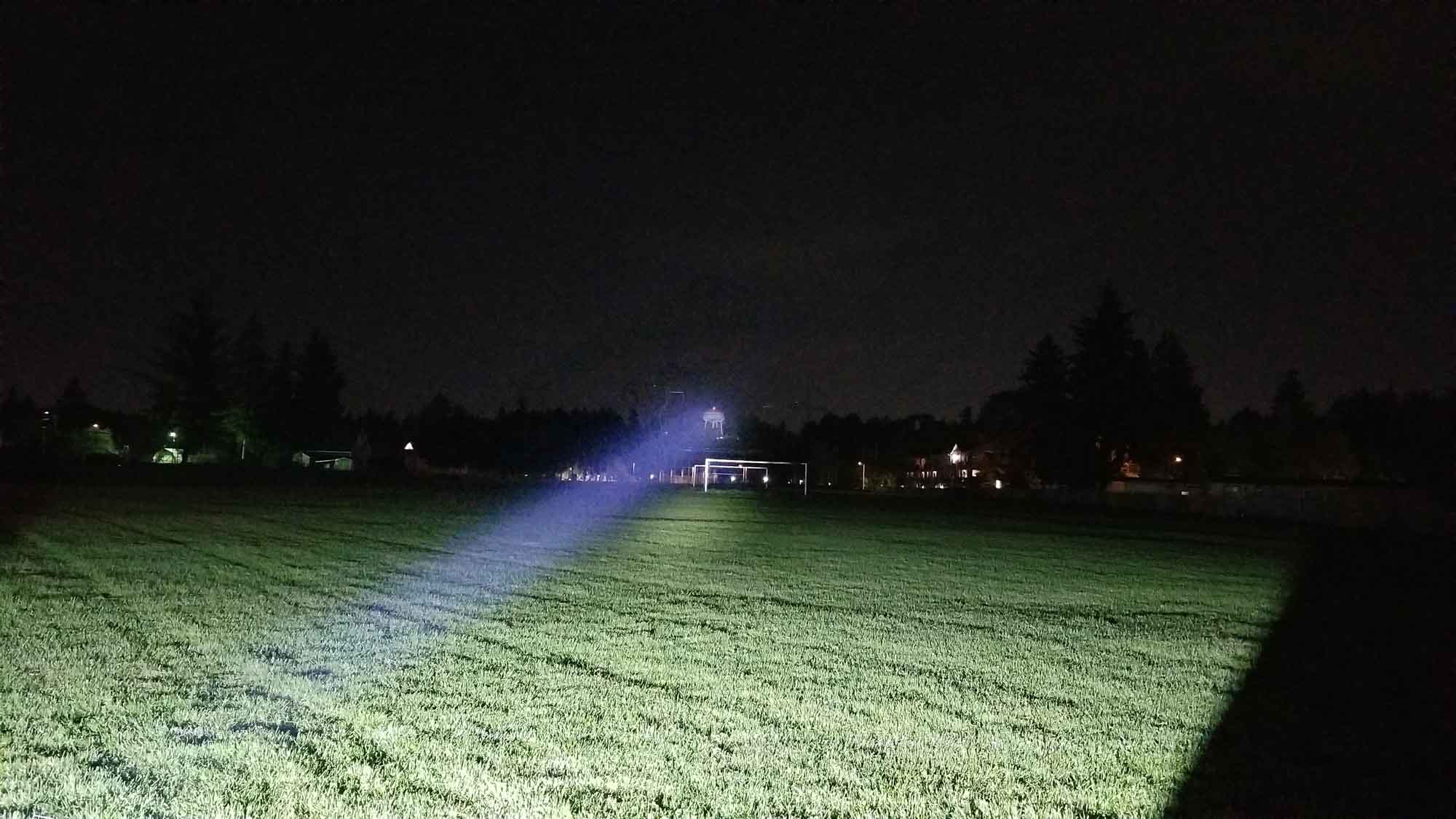
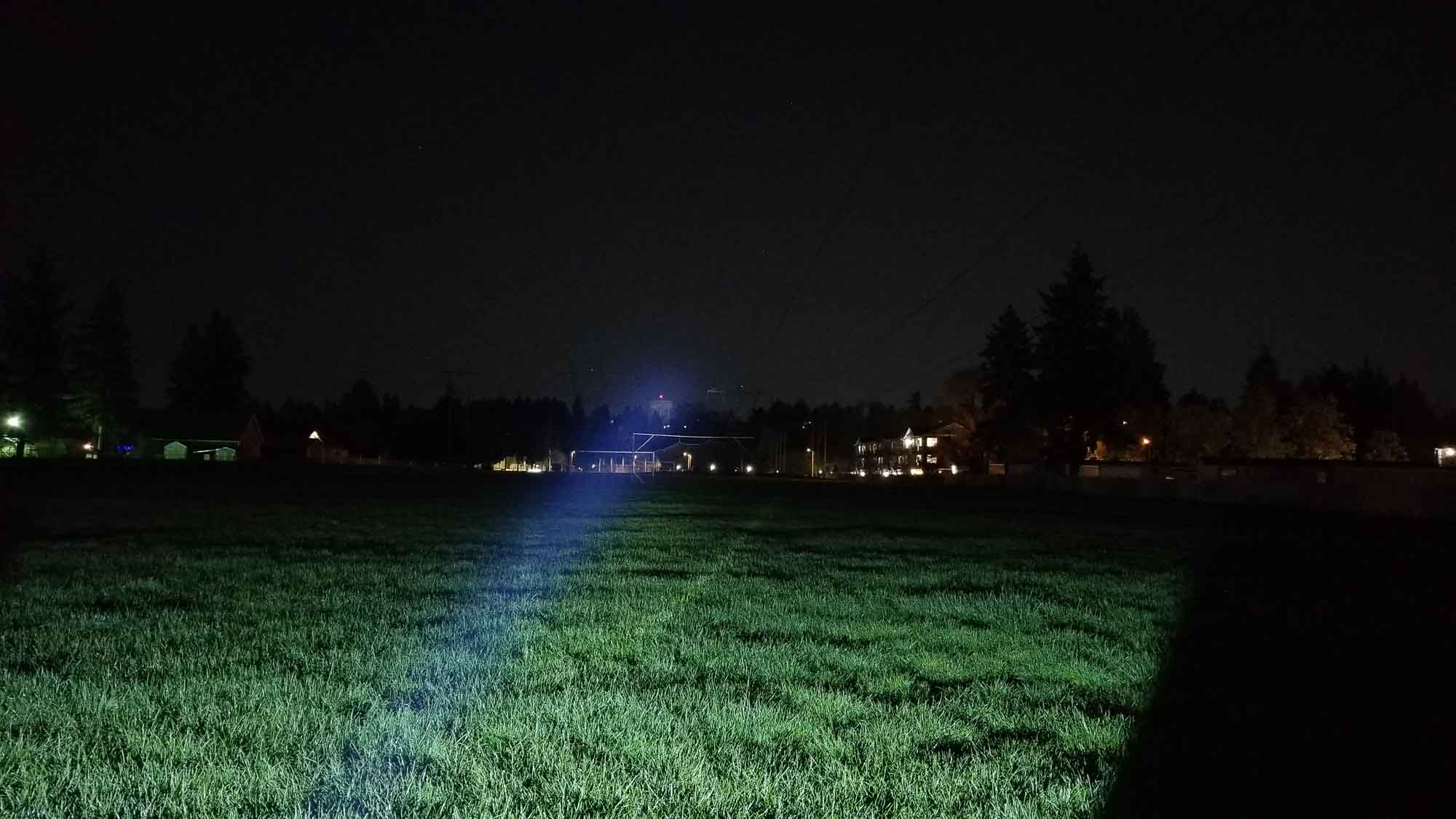
Disclaimer: This flashlight was sent to me for review at no cost by iTarlights. I have not been paid to review, nor have I been holding back on problems or defects.
Final Verdict
Pros
- Affordable
- Performs close to spec
- Nicely regulated driver
- Decent build quality
- Protective lens over aspheric lens
- Includes 2×21700 with bidirectional charging
Cons
- Dirty lenses!
- Next mode memory
- SOS as part of mode rotation
- Only sold on Alibaba (for now)
Explanation on star ratings:
1: Avoid: a match would be a better choice – 2: Poor: significant defect or issues; almost unusable – 3: Average: some defects or issues; but still usable 4: Good: recommended (minor issues) – 5: Great: highly recommended

4 stars: ★★★★
LEPs occupy a niche market segment of the flashlight world, and until recently, it was a niche closed off to some due to the high price of entry. Although LEPs have come down in price in the last year, some are still prohibitively expensive for some, especially those who would like to join the 3 km club. Well, here’s where iTarlights comes in, with a near 3 km LEP for under $200. Until recently, the cheapest near-3 km LEP was the Astrolux WP3, but it was a single cell light with a cheap driver and short runtimes.
The WL20 surprised me with the high-performing shine-through LEP module, delivering numbers closer to mirror-type modules, with a nicer beam. With 2x21700s on board, it delivers long runtimes with a nicely regulated driver, and the build quality is pretty decent. I appreciated seeing the protective lens over the aspheric lens as well.
Now, the dirty lenses are a major drag, and although I applaud the simple UI, I positively do not like next mode memory for any flashlight UI, LEP or EDC. I digress though, since for the price, you really can’t beat the iTarlights WL20. I just wish it (and the single cell WL30) was sold somewhere other than Alibaba. So, should you pick up a WL20? If you must have a LEP capable of 2800 meters of throw and don’t have $350 to spend, then by all means you should. The next closest 3 km LEP with 2×21700 is the Maxtoch Xsword L2K which runs $330. For value alone, I’d give it 5 stars, but all things considered, I have no trouble giving it 4 stars.
iTarlights WL20 for sale
1lumen selects and reviews products personally. We may earn affiliate commissions through our links, which help support our testing.